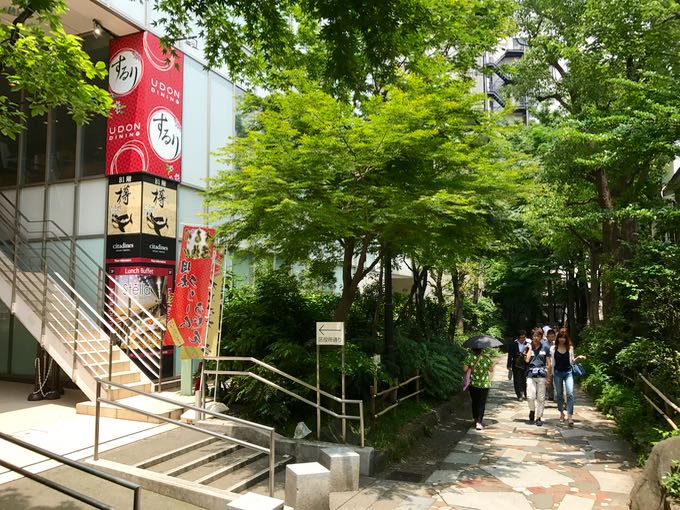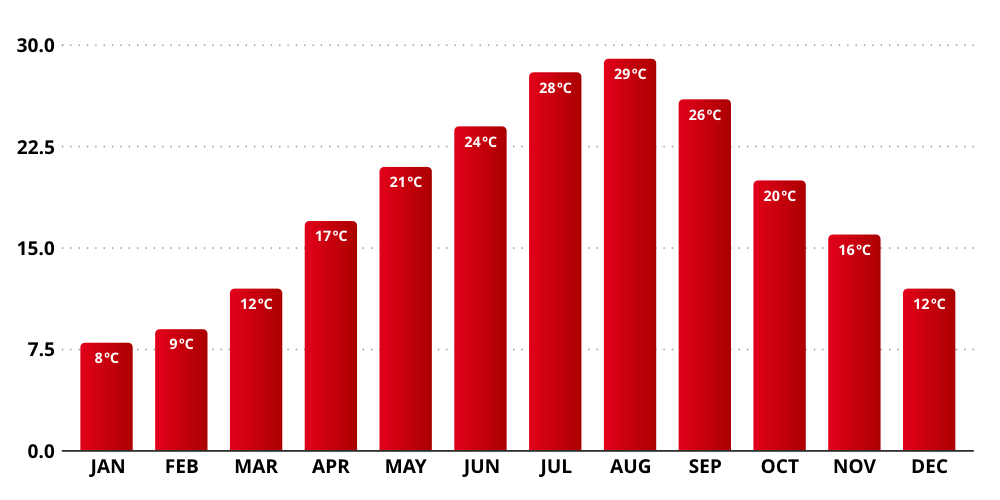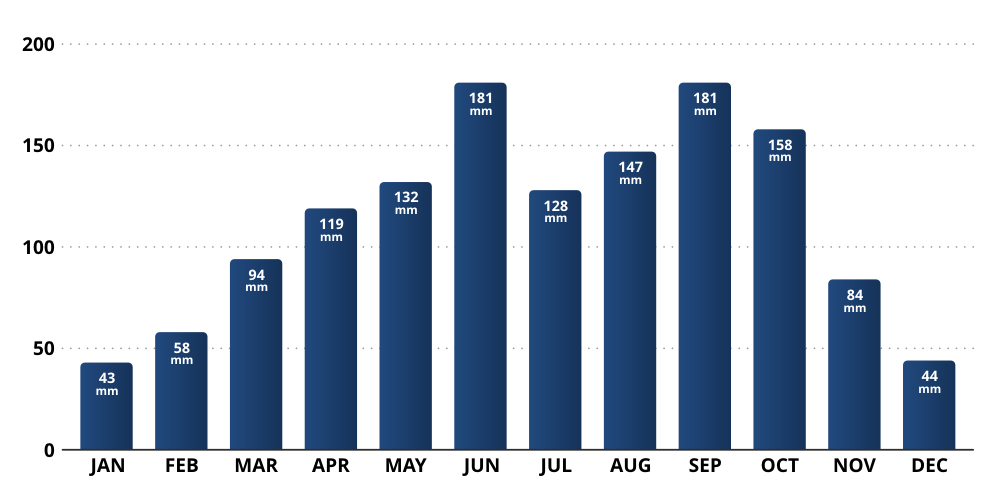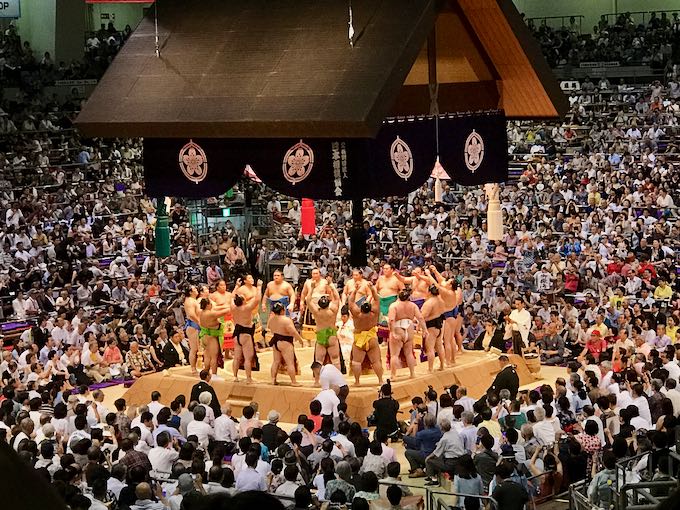See Also
Visiting Tokyo – My Advice
- The best months to visit Tokyo are March, April, October, and November. The weather is nearly perfect, with none of the heavy rains and high temperatures of summer. Sightseeing, outdoor activities, parks, and gardens are at their best.
- The Best Tokyo Hotels and Best Tokyo Hotels for Families get fully booked early. Book hotels as early as possible.
- Best Time for Good Weather: Late March to May and October to early December.
- Best Time for Sightseeing: March, April, October, and November.
- Best Time for a Honeymoon: Springtime (cherry blossoms) and late fall (foliage season) are the most romantic times to visit Tokyo.
- Best Time for Nightlife: Year-round Tokyo has plenty of going on at night.
- Best Time for Saving Money: January and February see fewer tourists but Tokyo is such a big business destination that the small drop in tourists doesn’t make a huge difference with hotel prices or saving money.
- The best area to stay in Tokyo depends mostly on your interests and doesn’t change depending on the time of year.
When’s the best time to visit Tokyo?
The months of March, April, and November are my favorite months to visit Tokyo as the weather is cool and it rains relatively less. April is also Sakura season while November is filled with autumn beauty.
Best Time To Visit Tokyo

Me and my two kids at a playground in Tokyo.
- Best Time for Tokyo Sightseeing: I’d say many of the best things to do in Tokyo can be enjoyed year-round but March, April, October, and November are generally the best months of the year to see the sights in Tokyo. Spring brings the beautiful Sakura season, a time when the cherry blossoms are in bloom and float in the air like snowflakes, creating a fantasy-like scene from late March to mid-April (timing of the cherry blossom varies a little every year). I find the weather in spring to be great for outdoor activities. In November, there is a slight chill in the air, but the weather is often idyllic, and you’ll enjoy the peak of autumn foliage while exploring the city. There is little rainfall, skies are clear, and temperatures are mild. July and August are typically the hottest and most humid times of year, and can be uncomfortable for sightseeing if you’re averse to humidity. Crowds are also at their peak, which means you’ll be bumping elbows with a lot of other sweaty tourists. No matter what time of year you go, major sights like Sensoji temple are best visited on a weekday morning, or later in the evening – Sensoji is typically deserted after dark, with all shops in Nakamise closed.
- Best Time to Visit Tokyo Disney Resort: The best time of year to visit Tokyo Disney Resort to avoid the biggest crowds and enjoy the best weather, is in the spring, before or after Golden Week which takes place at the end of April and beginning of May, but before the rainy season begins in June. The next best time is mid-November through early December. If you just want to ride as many attractions as possible and don’t mind the rain, visiting in June or October is ideal – on any very rainy day the crowds are minimal and most rides have shorter wait times. Tokyo Disney Sea (on the same property as Tokyo Disney and connected by monorail) will always have shorter lines than the Disney Resort.
- Best Time for Foliage: The colors in Tokyo, on average, are best viewed from mid-November through early December. Unlike the cherry blossoms which last for only a week, autumn foliage can usually be enjoyed over a couple of weeks. One of the city’s best spots to take in the colorful leaves is downtown. Icho Namiki Avenue hosts a stretch of gingko trees that are particularly magnificent when the leaves are transformed into a brilliant yellow shade in late November. Don’t miss Rikugien Gardens either, one of the capital’s most stunning places, especially in late autumn. By going soon after it opens at 9am, you can enjoy leaf-peeping with fewer crowds.
- Best Time for Shopping: Tokyo is a treasure trove when it comes to shopping. The best time to be in the city for shopping enthusiasts is during the clearance sales held twice a year, in summer and winter. The winter sale is mainly held during the year-end and the New Year holiday season, with both winter and fall items sold at bargain prices. You’ll find great deals at big department stores as well as the smaller shops throughout the nation – the sales attract big crowds just like a festival. The closing of the rainy season each year, about the third week in July, marks the opening of Tokyo’s famed end-of-summer sales, which is somewhat of a misnomer as summer has yet to hit its peak. This is your opportunity to score savings of around 30 to 50% on fashion, particularly designer clothing, and many other items as shops clear their inventory. Sundays tend to be the busiest shopping day of the week, with many families heading out together. On Mondays, many shops are closed, while some department stores close on Wednesdays. Going as soon as they open, typically at 10am on a Tuesday or Thursday, is your best bet for avoiding the biggest crowds and long lines.
- Best Time to Visit Tsukiji Fish Market: The Tsukiji Fish Market is the largest wholesale fish market in the world. It’s one of the most exciting places to be, whether you arrive in the wee hours of the morning for the tuna auctions, or later in the morning to enjoy a sushi breakfast. The market moved to the nearby Toyosu district in early November 2016. The next best time for visiting the new market is in January, which is the most delicious time for local seafood as fish naturally fatten up to survive the icy waters. Regardless of the month you plan to visit, to watch the famous Tuna Auction, you’ll need to be there around 3am. The opening hours are 3:30am to 6am, with two sets of 60 people allowed to watch the action. The first group can watch between 5:25am and 5:45am, while the second is allowed to view it between 5:50am and 6:10am. In order to get a spot in one of those groups, you need to be there between 3am and 4am. If that’s a bit too early for your liking, head to the market at 9am, when tourists are allowed in the inner market, after the hustle and bustle begins to wind down.
- High Season (mid-June through mid-September, late April through early May): – The weather is very hot and humid during Tokyo’s summer months, and it’s peak tourist season, so it will be filled with sweaty people too. It also falls during the rainiest part of the year, which is from early June through about July 20. On the upside, during rainy season, you’ll see hydrangeas in a variety of colors everywhere you look. By August, the heat is at its peak, and as it’s summer vacation for students and many adults have days off this month, crowds are especially dense. Mount Fuji’s official climbing season is July and August, making a high season visit a must for would-be climbers.
- Shoulder Season (April through mid-June – excluding late April and early May, mid-September through December): Shoulder season is generally the most pleasant time to be in Tokyo, particularly April and November, with relatively dry, sunny weather, although as the city is home to over 13 million, there’s really no such thing as a less crowded season. Residents and visitors flock to Tokyo’s urban parks in full force to see the cherry blossoms in April, and during Golden Week over the last few days of April into early May, crowds peak again. From mid-May through mid-June, you’ll have the best chance for slightly discounted hotel prices.
- Low Season (January through March): Winter is generally low season and can be a good time to visit if you don’t mind cooler weather. At this time of year, humidity is low and snow is rare, which means as long as you bring a warm coat, you’ll be comfortable exploring the city. This is also the best time for slightly lower accommodation rates, with the exception of Christmas to a few days after New Year’s, but don’t expect prices to plummet as they tend to be fairly stable, and expensive, year-round.

March, April, October, and November are the best months to visit Tokyo for good weather, sightseeing, and outdoor activities.
Tokyo Weather by Month
Temperature by Month (high in Celsius)

Rain by Month (mm)

- Tokyo Weather in January: January is Tokyo’s coldest and sunniest month. Bring a warm coat and your sunglasses if you’re heading to the city during the peak of winter. It rarely snows, and temperatures typically range around 7 to 10°C during the day, dipping to just above freezing at night. There is an average of 43mm of rainfall over nine days this month, which means an abundance of sunshine, although you’ll have a little less time to take advantage of it as compared to other times of the year. On New Year’s Day the sun sets at about 4:45pm, and by the end of January, it dips below the horizon at 5:07pm. (Average Max Temperature: 8°C. Average Precipitation: 43mm.)
- Tokyo Weather in February: February is not much different than January in Tokyo, with a slight warming as the average high temperature increases by a degree to 9°C, and there may be a little more cloud cover. You’ll still enjoy mostly sunny days with only 58mm of rain coming down over 11 days this month. Bring that warm coat and sunglasses, and if you plan to stay in a Japanese house, keep in mind that it may feel under-insulated, especially in traditional houses where the wind seems to blow straight through. Modern buildings, and trains, however, often feel overheated, which means layers are your best bet for staying comfortable both indoors and out. (Average Max Temperature: 9°C. Average Precipitation: 58mm.)
- Tokyo Weather in March: March brings the first signs of spring, with the weather warming up by several degrees on average, and getting a little bit wetter too. While your chances for sunshine remain the same, you’re more likely to experience intermittent showers, and when it does rain, it may be a bit heavier. Pack a rain jacket and plan on dressing in layers and you’ll be well-prepared for seeing the sights. By late March, locals start to think about Sakura, or cherry blossom, season. The beautiful flowers often begin blooming around March 30, and the city’s parks will be filled with hanami (flower viewing) parties. As the sun doesn’t go down until around 6pm, you’ll have more time to enjoy them too. (Average Max Temperature: 12°C. Average Precipitation: 94mm.)
- Tokyo Weather in April: Early April is one of the best times of the year to be in Tokyo. The Sakura season is at its peak and temperatures are quite pleasant, with average highs hovering around 17 to 18°C. The beautiful weather continues throughout the month and the days grow longer too, with the sun setting at about 6:30pm on April 30. When planning what to bring, consider that mornings and evenings tend to be cool and damp, while afternoons are often warm, which means a few short-sleeve shirts along with a couple of long-sleeve tops and a light jacket should suffice. (Average Max Temperature: 17°C. Average Precipitation: 119mm.)
- Tokyo Weather in May: May is another beautiful month in the city. The days are longer, with the sun rising about 4:30am and staying up until almost 7pm by May 31. You can expect temperatures during the day to be around 20 to 21°C, though it will be slightly rainier than April with 132mm falling over 16 days this month. Still, you will need those sunglasses as the sun is out more often than not. A light jacket or sweater for cooler mornings and evenings is all that is needed now. (Average Max Temperature: 21°C. Average Precipitation: 132mm.)
- Tokyo Weather in June: June ushers in the high heat and humidity, along with the rain. This is the start of Tokyo’s six-week rainy season, and in June, about 181mm of rain falls over 20 days, so you will need a light rain jacket or poncho, and ideally, light, water repellant or waterproof clothing. You can bring an umbrella, but you might want to wait and get one while you’re here because as soon the first drops of rain hit the street, you’ll find them sold everywhere you look. You’ll also see people handing out uchiwa fans for promos, grab some of those to make the heat a bit more bearable. (Average Max Temperature: 24°C. Average Precipitation: 181mm.)
- Tokyo Weather in July: July brings more hot and sticky weather. The rainy season continues until about the third week of July, while the average high temperature increases several degrees to 28°C. The rain can vary, with some days bringing intense downpours while others bring just occasional sprinkles. Because of the heat, a jacket may be unbearable, so packing lots of fast-drying, lightweight clothing may be your best bet, in addition to picking up a hand fan and umbrella while you’re here. (Average Max Temperature: 28°C. Average Precipitation: 128mm.)
- Tokyo Weather in August: While it’s still sweltering hot in August, with the average high temperature increasing to 29°C, the sun returns, putting the city in a festive mood once again. The bad news is that the high humidity combined with the heat means that it may be unbearable for those who aren’t used to it. Be sure to pack sweat-wicking clothes – many swear by Uniqlo’s AIRism, an iconic Japanese brand of functional underwear designed to quickly absorb and release trapped moisture, allowing the wearer to stay cool. (Average Max Temperature: 29°C. Average Precipitation: 147mm.)
- Tokyo Weather in September: September ushers in fall, which means the gradual decline of humidity and heat, but this month is also the darkest and wettest, with an average of 209mm of rainfall. Temperatures don’t start dropping significantly until late September. Though the average high temperature is 26°C., it’s not uncommon for temperatures to rise as high as 33 °C during the first few weeks of the month. (Average Max Temperature: 26°C. Average Precipitation: 181mm.)
- Tokyo Weather in October: The first half of October is similar to September: warm, dark and wet, though days are gradually beginning to cool. The average high is 20°C, with overnight lows at 15°C, so it’s not chilly enough for the leaves to turn just yet, but you may need a light jacket for cooler mornings and evenings, along with appropriate rain gear. The days are much shorter by month’s end, with sunset at about 4:45pm. (Average Max Temperature: 20°C. Average Precipitation: 158mm.)
- Tokyo Weather in November: November means autumn in Tokyo, with the city’s parks exploding with color. The skies are typically brilliant blue, and the maple trees turn scarlet. It’s cooler and drier, with average high temperatures around 17°C and much less precipitation. Many feel that after April, this is the best month to be in Tokyo. You may need a light jacket or sweater after dark, which is after 4:30pm at the end of the month. Wearing layers is a good idea this time of year, as it may be cool outside and hot inside in many places. (Average Max Temperature: 16°C. Average Precipitation: 84mm.)
- Tokyo Weather in December: December brings mostly cool, dry, late autumn days. While it will feel noticeably cooler, with high temperatures averaging 12°C and overnight lows of 4°C, a warm coat is usually plenty to keep you comfortable outdoors. Don’t forget those sunglasses as the sun shines brightly this time of year. With just 44mm of rainfall over nine days this month, you’re unlikely to get too wet.(Average Max Temperature: 12°C. Average Precipitation: 44mm.)
Tokyo Events and Festivals by Months

Tokyo Events in January
- New Year’s – New Year’s brings a number of different rituals and pastimes through Japan, including waking up early to view the year’s first sunrise. Visitors can join in on crowds taking part in hatsumode festivities, which is the year’s first visit to a shrine or temple, where wishes are made, new omamori (charms) are purchased, and old ones are returned to the shrine to be burned. Many Japanese are off work from December 29 through January 3, and many tourist attractions, shops and restaurants are closed.
- Winter Sales – Just after the New Year’s period, sales are held throughout the month. In Tokyo’s famous shopping districts like Shibuya, Shinjuku and Harajuku, you’ll find sales everywhere, from smaller fashion retailers to established department stores. Fukubukro, held the week after New Year’s Day, is a shopping tradition of offering mystery bags filled with heavily discounted items, and practically every shop participates.
- Sumo New Year Basho – This 10-day event typically held around the second and third week of January, is the first of six Grand Tournaments of Sumo that are held every year, and one of just three annual sumo events in Tokyo that count towards sumo rankings.
- Coming Of Age Day – On the second Monday of January each year, a ceremony is held at city halls across Japan, including Tokyo, to recognize those who’ve reached 20 years of age in the past year, the age that people are considered adults. Everyone can attend, and you’ll see women all done up with gorgeous hairstyles, makeup and in beautiful kimonos. As this is a national holiday and most Japanese have the day off, many of the major arteries are closed and cars are replaced with street performers. The event offers a good opportunity to have some fun and see young Japanese people in traditional dress.
- Sugamo Togenuki Jizo Taisai – This major festival is hosted by the Kogan-ji Temple on January 24, where some 20 priests read over the Sutra of Great Wisdom,” while countless stalls crowds its grounds and the surrounding streets, selling everything from traditional foods to a variety of merchandise.
Tokyo Events in February
- Setsubun – On February 3, the evening before spring, according to the Japanese lunar calendar, ceremonies are held at shrines throughout Japan, in an effort to ward off disasters and accidents, ensure good health and to bring good fortune. They typically feature local personalities and celebrities throwing beans and prizes to the audience. In Tokyo, Zojoji Temple, famed for its association with the long line of Tokugawa shoguns and for its proximity to Tokyo Tower, usually holds a bean flinging ceremony with men and women born in the same year as the current year of the Chinese zodiac kitted out in samurai garb.
- Kite Market – A Kite Market is held on the Day of the Horse every February at the Oji Inari Jinja Shrine. The annual market dates back to the Endo Period when kites considered to be lucky charms for preventing fires as they were said to “cut the wind,” thus stopping them from spreading.
- Nagashibina (Floating Ceremony of Paper Hina Dolls) – In this ceremony, an ancient Japanese tradition that’s been practiced for 1,000 years features dolls made of paper or plant materials that are sent down the river to exorcise disasters that can befall children. At the same time, balloons shaped like doves are released by women wearing long-sleeved kimonos.
- Valentine’s Day – In Japan, it’s women who do all of the gift buying for men on February 14th, though it’s not limited to husbands and boyfriends; friends, family and co-workers are all on the list too. Hotels and restaurants offer Valentine’s getaways and specials, and the Keikyu train line showcases a commuter car with heart designs and special seats. Men do the gift giving a month later on White Day.
- Tokyo Marathon – The Tokyo Marathon, typically held on the last Sunday in February, includes nearly 40,000 participants who run around Tokyo’s famous sightseeing spots. The course begins at the Tokyo Metropolitan Government Building and finishes at Tokyo Big Sight. There will be lots of cheers from people on the sidelines throughout to give encouragement to the runners.
Tokyo Events in March
- Dharma Doll Fair – This annual festive market known as the Jindaiji Daruma Ichi, is held over the first weekend of March at the Jindai-ji Temple in Chofu, a suburb of Tokyo, and features all types of Daruma dolls for good luck.
- Saint Patrick’s Day – The largest Saint Patrick’s Day event is held in Tokyo and features a parade where participants don traditional Japanese-style dress and Irish costumes. The city’s Omotesando shopping district is draped in tricolor flags and a cast of floats, while Irish dancers, leprechauns, Irish setters and wolfhounds, all entertain the crowds. The “voucher girls,” young, attractive women sent from the Irish pubs, pass out free beer.
- Fire-walking Festival – This festival held in mid-March offers the chance to witness the rigorous ascetic exercises of the mountain priests of Takao-san. The highlight is the sight of yamabushi monks courageously walking through the flame walk chanting. Spectators can participate after the fire has been put out, when the temperature of the walking path is just slightly warm.
- Rikugien Garden Illumination – During the second half of March, and into early April, the shidare zakura (weeping cherry tree) and feudal lord’s garden are lit up, creating a spectacular spring sight. A symbol of the park, the tree measuring nearly 50 feet tall and over 65 feet wide. After dark, it looks as if it’s floating against the sky, and during the day, it’s beautifully illuminated by the spring sunlight.
Tokyo Events in April
- Kanamara Festival – This festival is one that might cause your jaw to drop if you aren’t aware of it beforehand. The “Festival of the Iron Phallus” is held in Kawasaki, near Tokyo, and features an over 32-foot-tall pink penis paraded through the streets to offer prayers for conception, safe childbirth and marital happiness.
- Hana Festival – The Floral Festival is an event held on April 8 that celebrates Buddha’s birthday. Small shrines are decorated with flowers, baby Buddha figurines, and parades with children donning fancy attire pull a papier-mâché white elephant. It’s held in a number of places throughout the city, including the temples, like Sensoji Temple where hydrangea tea is served in the morning.
- Annual Spring Festival – Held over the third weekend in April at the Yasukuni Shrine, this festival features traditional dance and martial arts performances.
- Golden Week – This is a collection of four non-consecutive holidays that are timed to coincide with Japan’s most dependable spring weather. It takes place within a week over the end of April and beginning of May. As many Japanese have this time off from work, this is the busiest travel season of the year, with popular sightseeing spots, hotels and public transportation overcrowded. The highlight of the week is Children’s Day on May 5, when families pray for the health and success of their sons.
- Earth Day Tokyo – This is the country’s biggest Earth Day-related event. Hosted in Yoyogi Park, it features musical performances, healthy foods and a variety of environmentally-focused informational booths.
Tokyo Events in May
- Kanda Festival – Held over the weekend closest to May 15 in odd-numbered years at the Kanda Myojin Shrine, this huge festival attracting two million spectators annually features a parade of wagons filled with dancers, floats and some 200 mikoshi (a portable Shinto shrine that carries a deity to another place during the festival and then back again), to honor the deities of the Kanda Shrine. Many geisha and others dressed in traditional garb will also take part.
- Hanazono Shrine Festival – Held on the closest weekend to May 28 each year, this traditional festival at Hanazono Shrine features an array of the usual food stalls and ceremonial rites. The highlight is the shinkosai procession of floats and mikoshi.
Tokyo Events in June
- Sanno Festival – This festival is one of Tokyo’s most famous and takes place in mid-June in even-numbered years, alternating with the Kanda Festival. It features a long parade that runs for more than 15 miles through the streets of central Tokyo.
- Hydrangea Festival – The Hydrangea Festival is held at Hakusan Jinja Shrine in early to mid-June. A number of street stands sell hydrangea planters and all types of other festive items along the approach to the shrine to welcome visitors.
Tokyo Events in July
- Tokyo Summer Festival – This music festival takes place during the entire month of July with a variety of acts and shows all over Tokyo featuring music from around the world.
- 46,000 Days/Shiman Rokusen-nichi – The “day of 46,000” is held at the Sensou-ji Temple. It’s said that visiting the temple on July 9 and 10 will give you credit for visiting on 46,000 regular days. Thousands come to the event and hundreds of stalls sell potted cherry plants and wind chimes until midnight.
- Sumida River Fireworks Display – The oldest fireworks show in the world, and one of the largest fireworks displays in the country, takes place in late July in the historic Asakusa district of Tokyo. It’s said to date back to Edo times (1603-1867), when firework makers would come here to compete some of the most spectacular displays.
Tokyo Events in August
- Fukagawa Hachiman Festival – Held in mid to late-August, the tri-annual Hon-matsuri is one of the city’s big three festivals. It includes a large parade of mikoshi that runs along a four-mile route, getting liberally sprayed with water throughout.
- Asakusa Samba Carnival – One of Tokyo’s liveliest and most popular summer festivals, the Asakusa Samba Carnival draws 500,000 spectators each year, celebrating Brazilian culture in late August with samba in the city.
- Koenji Awa Odori Festival – This large scale festival held in late August features street dance and is modelled on Shikoku’s Awa Odori festival. More than a million come to watch the thousands dancing in the streets to rhythmic traditional music.
Tokyo Events in September
- Hibiya Oktoberfest – Oktoberfest is held in the city’s oldest park, Hibiya Park, an Edwardian- and Gothic-style park established in 1903. It offers a taste of German culture, food, drink and entertainment over 10 days in mid-September.
- Sumo Autumn Basho – This 15-day event in mid-September is the last chance of the year to watch a professional sumo tournament in Tokyo.
- Tokyo Game Show – The biggest video game conference in Japan is held in Tokyo’s Chiba district, attracting legions of video game enthusiasts and industry insiders, with over quarter-million total attendees each year.
- Ikebukuro Festival – This large festival takes place in late September with an opening ceremony on the first evening followed by a mikoshi palanquin festival the next day. It includes a mikoshi parade accompanied by a shishimai lion dance, taiko drumming and ohayashi Japanese instrumental music. Later that evening is a yoimikoshi palanquin parade and an Okinawan eisa dance show.
Tokyo Events in October
- Tokyo Yosakoi Contest – This large team dance competition is held in nine different venues, including the area around Ikebukuro Station. It brings more than 100 teams together in an average year, including champion teams from throughout the country who participate and perform various styles of yosakoi dances.
- Dai Ginza Festival – This week-long festival in mid-October celebrates the anniversary of the Meiji Restoration and features a parade of sound and light through Ginza Dori, a charity bazaar, musical performances, the Hachi-Cho Shrine Pilgrimage and a photo contest along with some great sales in the district’s big-name stores.
- Tokyo International Film Festival – This annual competitive film festival held from the last week of October to the first week of November is one of the largest film events in Asia. It screens a wide range of Japanese and Asian films with awards given out in a variety of categories.
- Kiku Kuyo – A “memorial service for chrysanthemums,” on this day celebrated in late October, old chrysanthemums that have been donated to the Sensoji Temple are replaced with new ones brought in by parishioners. There are beautiful displays of the flowers and the famous Golden Dragon dance is performed in hopes of attracting good fortune and prosperity.
- Halloween – Just a few years ago Halloween was mostly a non-event in Tokyo, but today it’s popular with young Japanese adults and teenagers. Thousands of costumed people gather in the area around Center Gail Street in Shibuya.
Tokyo Events in November
- Tokyo Jidai Matsuri – Celebrated annually on November 3, Culture Day is a national holiday and includes a historical parade that recreates Tokyo’s history and culture, with participants representing a variety of eras from the 7th-century through today.
- Shibuya Festival – This fun community festival takes places over the first weekend of November and features a variety of family events at various venues, including Yoyogi Park Event Square, as well as food and parades.
- Tori-no-ichi – This famous annual fair is held on the day of the rooster (tori), which comes every 12 days in November. Generally the first day, November 4, is considered the most important, with crowds gathering at the Asakusa Otori Shrine to pray for good fortune, good business and health. Markets spring up around the shrines, with the largest in Tokyo’s Asakusa area attracting tens of thousands of visitors to some 200 stalls. Symbolic charms called kumade (a rake of bamboo) are sold to encourage a prosperous year of business, along with a large variety of goods and food like yatsugashira potatoes, which are believed to aid fertility.
- Labor Thanksgiving Day – This national holiday is observed on November 23 and is an occasion for giving thanks to one another for work done throughout the year. It includes a number of different events, like the Nagano Labor Festival which focuses on human rights, peace and the environment.
Tokyo Events in December
- Gishi-sai – This festival is held at Sengakuji Temple on December 14 each year to honor the 47 loyal retainers in Akoh. Visitors come to pay respects to the vassals of Akoh at their burial site and watch the procession of volunteers who parade through the streets dressed as the vassals.
- Setagaya no Boro Ichi – The biggest antique flea market in Japan, Setagaya no Boro Ichi dates back to 1578 and is held annually on December 15 and 16 on the streets of Setagaya. It brings together more than 700 dealers selling wares that range from arts and crafts to antiques and secondhand goods.
- Emperor’s Birthday – This national holiday celebrated on December 23 is marked by flags, banners and a special address by the emperor himself. This is one of the two days of the year when the emperor and imperial family make a public appearance on a palace balcony, acknowledging the birthday wishes of the crowd of well-wishers waving Japanese flags.
- New Year’s Eve – The New Year celebration takes places over December 29 through January 3, with much of the city shutting down for the holiday. On December 31, Japanese clean their homes in a ritual known as O souji before placing a shimekazari on their door which indicates their home has been purified and is ready to welcome the divinities. Just before midnight, fireworks are set off over Tokyo Bay and the Watch-Night Bell rings 108 times at temples throughout the country.
 Santorini Dave was started in 2011 when I posted a short guide to visiting Santorini with kids. Now, my site publishes regularly updated guides to
Santorini Dave was started in 2011 when I posted a short guide to visiting Santorini with kids. Now, my site publishes regularly updated guides to
Which month is a good time to visit Sakura City? I heard it is in October, is it true? Thanks for your time.
Rgds,
Eddie
Singapore
Sakura City is near Tokyo and thus the best times to visit are March to May and October to early December.
We’ll have 10 days to visit Tokyo and Kyoto (as part of a trip to Thailand). Is October or November a better month to visit Japan? Concerned about weather, foliage, and rain. Thanks!
Both months are good for visits to Tokyo and Kyoto. October is finally cooler after lingering humidity in September dissipates, with temperatures mostly in the 60s and 70s, with moderate rain. November, however, is generally considered even better, with less rain and slightly cooler temperatures (mostly in the 50s and 60s) that usher in the autumn changing of the leaves toward the end of the month for which many destinations, including Kyoto, is famous. Note, however, that there are always fluctuations, and no one can predict weather. In any case, be sure to pack a jacket for cool evenings that can be chilly.
Would you give any preference for visiting Tokyo in the spring (April or May) or Fall (October or November)? What is your favorite month to visit Tokyo and Japan? Our plans are largely based around Tokyo but we may get to some other areas for 3 or 4 nights.
Both seasons are considered optimal as far as weather is concerned, with mostly pleasant and cool temperatures, so it’s mostly a matter of personal preference. Azaleas and peony are two flowers that bloom in the capital in April/May, with lots of popular viewing spots (like Nezu Shrine for its azaleas). Likewise, autumn is popular for fall foliage, though you won’t have much opportunity for that in Tokyo. In any case, if you’re going to a city famous for its autumn leaves (like Hakone – usually late October, or Kyoto – November), make reservations far in advance. In Tokyo, that won’t be a problem, and on the plus side, foreign tourists are fewer than in summer. Frankly, it would be hard to pick a favorite month in spring or fall. Both seasons are great.